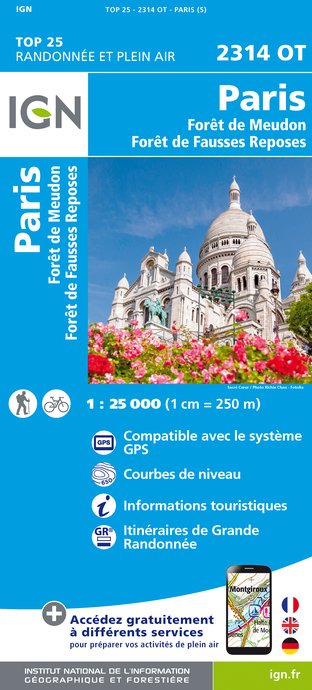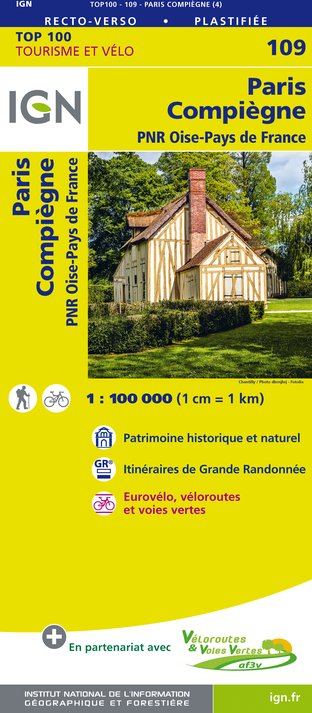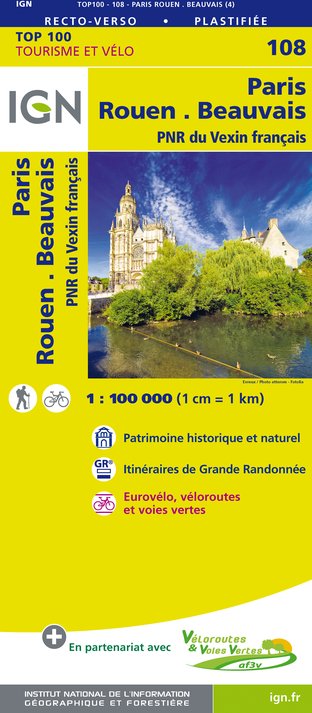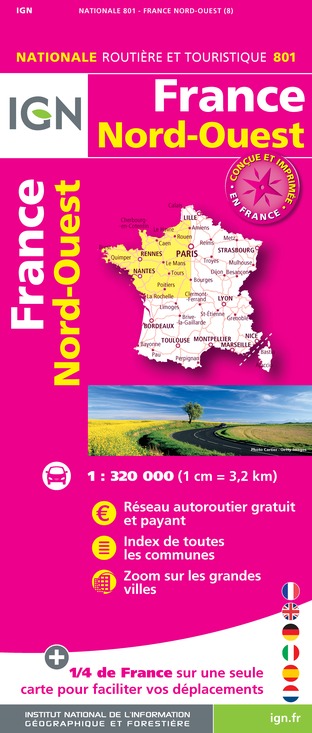Waarschuwing
Waarschuwingen
Type oefening
Wandel
Presentatie
Kaart
Stappen
Punten van interesse
Cirkwi's opdracht
Beoordelingen en recensies
Zie rondom
Het Wapen van Parijs "Fluctuat nec mergitur"



Credit : Bluebear2
De Cirkwi brief
Ontdek Parijs: Een historische reis door zijn symbolen
Als schrijver voor een reismagazine, ben ik enthousiast om u kennis te laten maken met een unieke reis samengesteld door Balades Fluviales Fabienne Lemoine Fondateur, die een intieme verkenning belooft van het rijke erfgoed van Parijs via zijn iconische symbolen en wapenschilden. Deze reis gaat niet alleen over het herbeleven van de geschiedenis; het gaat ook om het ontdekken van de essentie van de ontembare geest van Parijs, verankerd in zijn beroemde motto "Fluctuat nec mergitur". Terwijl we ons verdiepen in de pittoreske landschappen en architectonische wonderen die de tand des tijds hebben doorstaan, zullen we een verhaal ontdekken van veerkracht, prestige en onwankelbare eer dat het motto van de stad belichaamt. Doe met ons mee om een ander stukje Parijs te ervaren, ver weg van de platgetreden toeristische paden.
Een reis van onderscheidende technische aspecten
Deze zorgvuldig samengestelde route van Balades Fluviales Fabienne Lemoine Fondateur beslaat ongeveer 12,92 km en varieert in hoogte van 63 meter tot 27 meter, met een kleine hoogteverschil dat wijst op een relatief gemakkelijke tocht die de meeste mensen beheersbaar zouden vinden. Het zorgvuldige ontwerp zorgt voor een naadloze overgang van het ene bezienswaardigheid naar het andere zonder onnodige inspanning. Verwachte positieve hoogteveranderingen schommelen tussen de 109 en 107 meter, wat wijst op een zachte helling die geschikt is voor deelnemers van alle leeftijden, waardoor het een technisch toegankelijke reis is door het historische hart van Parijs.
Seizoensgebonden advies voor ontdekkingsreizigers in Parijs
Elk seizoen in Parijs biedt een unieke setting voor deze symbolische reis. In het voorjaar bloeit de stad en biedt het een pittoreske omgeving ideaal om te verkennen. De zomer brengt langere dagen, maar ook grotere drukte; vroege ochtend- of late avondtours worden aanbevolen. De herfst laat de stad in warme tinten zien, perfect voor rustige wandelingen, terwijl de winter, hoewel kouder, vaak helderdere dagen biedt. Ongeacht het seizoen, zijn comfortabele wandelschoenen een must, en bereid je altijd voor op onverwachte regenbuien met een paraplu of regenjas om een aangename en ononderbroken verkenning te garanderen.
Het hart van de Franse geschiedenis en cultuur
Parijs is in zijn essentie niet alleen de hoofdstad van Frankrijk, maar ook de kern van zijn historische en culturele evolutie, diep verweven met de identiteit van het land. De stad, historisch gezien een broedplaats voor geleerden, kunstenaars en revolutionairen, heeft een erfenis die eeuwen beslaat. De wapenschilden en symbolen die je tegenkomt, belichamen verhalen van veerkracht, revolutie en wedergeboorte die niet alleen de stad, maar ook het land hebben vormgegeven. Terwijl we deze route afleggen, zijn we niet alleen getuige van architectonische wonderen, maar stappen we ook in een levend, ademend verhaal van menselijke vindingrijkheid en geest die nog steeds invloed heeft op de wereld.
Weerinzichten voor de avonturier in Parijs
Het klimaat van Parijs is overwegend oceanisch, met milde winters en aangenaam warme zomers, waardoor het het hele jaar door een bestemming is. Echter, de beste tijd om deze symbolische reis te maken is in het voorjaar (maart tot mei) of de herfst (september tot november). In deze periodes zijn de temperaturen meestal mild en zijn er minder toeristen, waardoor u een meer ontspannen ervaring krijgt van het rijke weefsel van geschiedenis en cultuur van de stad. Controleer altijd de weersvoorspelling voordat u op reis gaat, want Parijs staat bekend om zijn onverwachte regenbuien, ongeacht het seizoen.
Als schrijver voor een reismagazine, ben ik enthousiast om u kennis te laten maken met een unieke reis samengesteld door Balades Fluviales Fabienne Lemoine Fondateur, die een intieme verkenning belooft van het rijke erfgoed van Parijs via zijn iconische symbolen en wapenschilden. Deze reis gaat niet alleen over het herbeleven van de geschiedenis; het gaat ook om het ontdekken van de essentie van de ontembare geest van Parijs, verankerd in zijn beroemde motto "Fluctuat nec mergitur". Terwijl we ons verdiepen in de pittoreske landschappen en architectonische wonderen die de tand des tijds hebben doorstaan, zullen we een verhaal ontdekken van veerkracht, prestige en onwankelbare eer dat het motto van de stad belichaamt. Doe met ons mee om een ander stukje Parijs te ervaren, ver weg van de platgetreden toeristische paden.
Een reis van onderscheidende technische aspecten
Deze zorgvuldig samengestelde route van Balades Fluviales Fabienne Lemoine Fondateur beslaat ongeveer 12,92 km en varieert in hoogte van 63 meter tot 27 meter, met een kleine hoogteverschil dat wijst op een relatief gemakkelijke tocht die de meeste mensen beheersbaar zouden vinden. Het zorgvuldige ontwerp zorgt voor een naadloze overgang van het ene bezienswaardigheid naar het andere zonder onnodige inspanning. Verwachte positieve hoogteveranderingen schommelen tussen de 109 en 107 meter, wat wijst op een zachte helling die geschikt is voor deelnemers van alle leeftijden, waardoor het een technisch toegankelijke reis is door het historische hart van Parijs.
Seizoensgebonden advies voor ontdekkingsreizigers in Parijs
Elk seizoen in Parijs biedt een unieke setting voor deze symbolische reis. In het voorjaar bloeit de stad en biedt het een pittoreske omgeving ideaal om te verkennen. De zomer brengt langere dagen, maar ook grotere drukte; vroege ochtend- of late avondtours worden aanbevolen. De herfst laat de stad in warme tinten zien, perfect voor rustige wandelingen, terwijl de winter, hoewel kouder, vaak helderdere dagen biedt. Ongeacht het seizoen, zijn comfortabele wandelschoenen een must, en bereid je altijd voor op onverwachte regenbuien met een paraplu of regenjas om een aangename en ononderbroken verkenning te garanderen.
Het hart van de Franse geschiedenis en cultuur
Parijs is in zijn essentie niet alleen de hoofdstad van Frankrijk, maar ook de kern van zijn historische en culturele evolutie, diep verweven met de identiteit van het land. De stad, historisch gezien een broedplaats voor geleerden, kunstenaars en revolutionairen, heeft een erfenis die eeuwen beslaat. De wapenschilden en symbolen die je tegenkomt, belichamen verhalen van veerkracht, revolutie en wedergeboorte die niet alleen de stad, maar ook het land hebben vormgegeven. Terwijl we deze route afleggen, zijn we niet alleen getuige van architectonische wonderen, maar stappen we ook in een levend, ademend verhaal van menselijke vindingrijkheid en geest die nog steeds invloed heeft op de wereld.
Weerinzichten voor de avonturier in Parijs
Het klimaat van Parijs is overwegend oceanisch, met milde winters en aangenaam warme zomers, waardoor het het hele jaar door een bestemming is. Echter, de beste tijd om deze symbolische reis te maken is in het voorjaar (maart tot mei) of de herfst (september tot november). In deze periodes zijn de temperaturen meestal mild en zijn er minder toeristen, waardoor u een meer ontspannen ervaring krijgt van het rijke weefsel van geschiedenis en cultuur van de stad. Controleer altijd de weersvoorspelling voordat u op reis gaat, want Parijs staat bekend om zijn onverwachte regenbuien, ongeacht het seizoen.
Automatisch gegenereerd.
IGN kaarten

2314OT - PARIS FORÊT DE MEUDON FORÊT DE FAUSSES REPOSES
Uitgever : IGN
Verzameling : TOP 25 ET SÉRIE BLEUE
Ladder : 1:25 000
13.90€

119 PARIS SENS PNR DU GÂTINAIS FRANÇAIS
Uitgever : IGN
Verzameling : TOP 100
Ladder : 1:100 000
8.40€

190 PARIS CHANTILLY FONTAINEBLEAU
Uitgever : IGN
Verzameling : TOP 100
Ladder : 1:100 000
8.40€

118 PARIS CHARTRES PNR DE LA HAUTE VALLÉE DE CHEVREUSE
Uitgever : IGN
Verzameling : TOP 100
Ladder : 1:100 000
8.40€

109 PARIS COMPIÈGNE PNR OISE-PAYS DE FRANCE
Uitgever : IGN
Verzameling : TOP 100
Ladder : 1:100 000
8.40€

108 PARIS ROUEN BEAUVAIS PNR DU VEXIN FRANÇAIS
Uitgever : IGN
Verzameling : TOP 100
Ladder : 1:100 000
8.40€

D75-95 ÎLE-DE-FRANCE OUEST
Uitgever : IGN
Verzameling : CARTES DÉPARTEMENTALES IGN
Ladder : 1:150 000
5.90€

D77 SEINE-ET-MARNE
Uitgever : IGN
Verzameling : CARTES DÉPARTEMENTALES IGN
Ladder : 1:150 000
5.90€

NR08 CENTRE-VAL DE LOIRE
Uitgever : IGN
Verzameling : CARTES RÉGIONALES IGN
Ladder : 1:250 000
6.80€

NR03 ÍLE DE FRANCE
Uitgever : IGN
Verzameling : CARTES RÉGIONALES IGN
Ladder : 1:250 000
6.80€

NR01 HAUTS-DE-FRANCE
Uitgever : IGN
Verzameling : CARTES RÉGIONALES IGN
Ladder : 1:250 000
6.80€

801 FRANCE NORD OUEST
Uitgever : IGN
Verzameling : CARTES NATIONALES IGN
Ladder : 1:320 000
6.10€

EUROPE
Uitgever : IGN
Verzameling : DÉCOUVERTE DES PAYS DU MONDE IGN
Ladder : 1:2 500 000
7.00€
Technische informatie
Wandel
Moeilijkheid
Niet gespecificeerd
Afstand
13 km
Type oefening
Wandel
Meer informatie tonen
Hoogteprofiel
Startpunt
75004
Paris
Lat : 48.856414Lng : 2.3517394
Stappen
Punten van interesse
Gegevensauteur
Beoordelingen en recensies
Om te zien rondom










